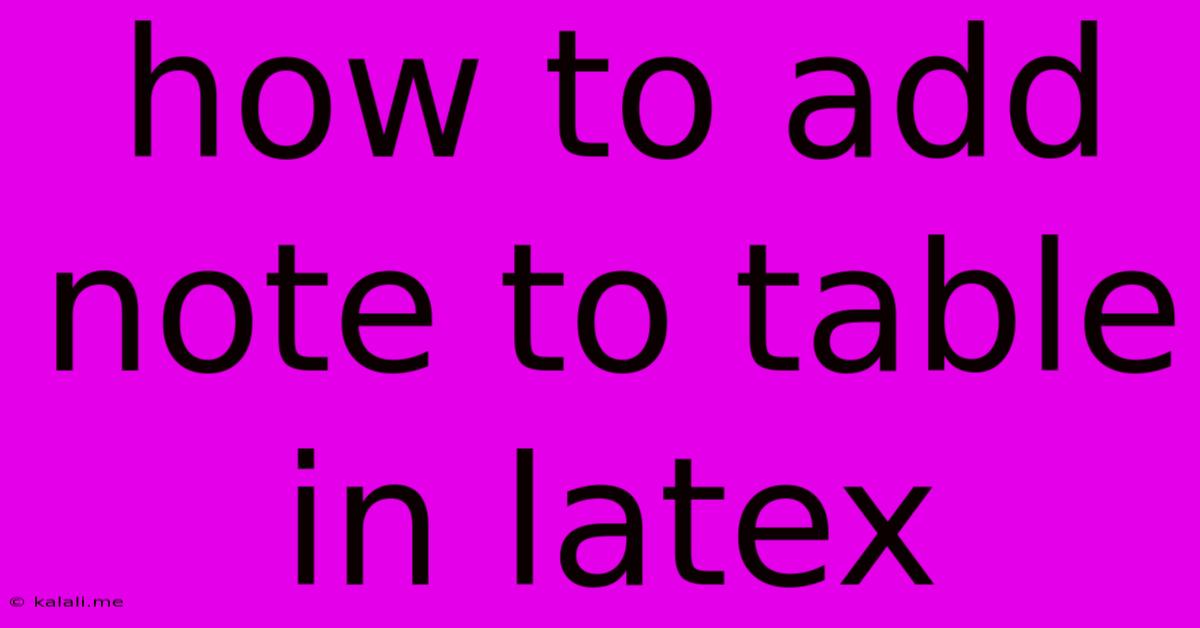How To Add Note To Table In Latex
Kalali
May 23, 2025 · 3 min read

Table of Contents
How to Add Notes to Tables in LaTeX: A Comprehensive Guide
Adding notes to your LaTeX tables is crucial for clarity and providing additional context to your data. This guide will walk you through several methods for adding notes, from simple footnotes to more complex explanations, ensuring your tables are both informative and visually appealing. This guide covers various methods, including using the \footnote command, the threeparttable package, and the booktabs package for enhanced table formatting. Mastering these techniques will elevate the professionalism and readability of your LaTeX documents.
Why Add Notes to Tables?
Well-structured tables are essential for presenting data effectively. However, simply presenting the data isn't always sufficient. Notes provide crucial context, allowing you to:
- Clarify data: Explain abbreviations, units of measurement, or any unusual values.
- Provide additional information: Offer further details, references, or statistical significance.
- Improve readability: Guide the reader through the table's structure and content.
Methods for Adding Notes to Tables
Here are three common and effective approaches for adding notes to your LaTeX tables:
1. Using the \footnote command: Simple Footnotes
The simplest way to add a note is using LaTeX's built-in \footnote command. This is ideal for short, concise explanations.
\begin{table}[h]
\centering
\begin{tabular}{|c|c|}
\hline
Data & Value \\
\hline
A & 10\footnote{This is a simple footnote.} \\
B & 20 \\
C & 30\footnote{Another footnote.} \\
\hline
\end{tabular}
\caption{Simple Table with Footnotes}
\label{tab:simple}
\end{table}
This produces a table with footnotes indicated by superscript numbers. Remember that this method is best suited for short, single-line notes.
2. Leveraging the threeparttable Package: Enhanced Table Notes
For more complex notes or multiple notes, the threeparttable package offers superior control. This package allows you to create table notes (footnotes, table notes, and other types of explanatory text) which are placed separately from the main table, improving clarity and layout. You'll need to include \usepackage{threeparttable} in your document's preamble.
\begin{table}[h]
\centering
\begin{threeparttable}
\begin{tabular}{|c|c|}
\hline
Data & Value \\
\hline
A & 10 \\
B & 20 \\
C & 30 \\
\hline
\end{tabular}
\begin{tablenotes}
\item[1] This is a table note. It can be longer and more detailed than a footnote.
\item[2] Another table note explaining specific data points.
\end{tablenotes}
\end{threeparttable}
\caption{Table with Table Notes using threeparttable}
\label{tab:threeparttable}
\end{table}
This produces a table with the notes clearly separated beneath the table, numbered for easy reference.
3. Combining booktabs for Enhanced Aesthetics and Notes
For visually appealing tables, integrate the booktabs package with either \footnote or threeparttable. booktabs provides elegant horizontal rules and enhances overall readability. Remember to include \usepackage{booktabs} in your preamble.
\begin{table}[h]
\centering
\begin{threeparttable}
\begin{tabular}{lcc}
\toprule
Data & Value & Note \\
\midrule
A & 10 & \tnote{1} \\
B & 20 & \\
C & 30 & \tnote{2} \\
\bottomrule
\end{tabular}
\begin{tablenotes}
\item[1] This data point is statistically significant.
\item[2] This value is an average of multiple measurements.
\end{tablenotes}
\end{threeparttable}
\caption{Table using booktabs and threeparttable}
\label{tab:booktabs}
\end{table}
This example combines the clean look of booktabs with the note handling capabilities of threeparttable, resulting in a professional and well-organized table.
Choosing the Right Method
The best method depends on your needs:
- Simple footnotes: Use
\footnotefor short, single-line notes. - Complex notes: Use
threeparttablefor multiple, detailed notes or when better organization is needed. - Visually appealing tables: Combine
booktabswith either\footnoteorthreeparttablefor enhanced aesthetics.
By mastering these techniques, you can create LaTeX tables that are not only data-rich but also clear, well-organized, and easy to understand. Remember to always prioritize clarity and ensure your notes effectively enhance the reader's understanding of your data.
Latest Posts
Latest Posts
-
If Your 35 What Year Was You Born
Jul 12, 2025
-
How Many Cups Is 1 Pound Of Cheese
Jul 12, 2025
-
30 X 30 Is How Many Square Feet
Jul 12, 2025
-
How Much Does A Half Oz Weigh
Jul 12, 2025
-
Calories In An Omelette With 3 Eggs
Jul 12, 2025
Related Post
Thank you for visiting our website which covers about How To Add Note To Table In Latex . We hope the information provided has been useful to you. Feel free to contact us if you have any questions or need further assistance. See you next time and don't miss to bookmark.